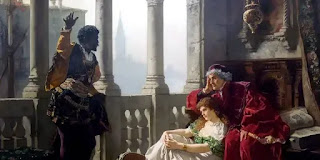Issues of Gender and Race in Othello
In many of his works, William Shakespeare explores ideas of gender differences and racial tensions. Othello, a play whose characters are judged again and again based on appearances and outward characteristics, is one such work. Here, the protagonist’s different ethnic background provides a platform for probing ideas of racial conflict. Similarly, the presence of well-developed yet opposing female characters adds a dimension of gender conflict and feminist views. These issues are crucial as they provide the catalyst for feeding Othello’s Jealousy and working the tragedy of the play. They intersect in the marriage of Othello and Desdemona, the destruction of which becomes Iago’s mission.
Women are an integral part of Othello. Women in Othello are portrayed with complexity and obvious tension between feminist and anti-feminist ideas. The chastity of a woman is highly valued, and Desdemona’s perceived infidelity helps drive the action of the play, ultimately leading to the deaths of many characters, including herself and her husband Othello. Iago’s hatred of women is evident throughout the play and could be part of his motivation to lead Othello to such jealousy. Desdemona and Emilia, her waiting lady, provide the central conflict for feminist and gender ideas. Earlier in the play, Emilia provides the feminist voice of Othello, asserting her independence from her husband and even admitting that she would commit adultery if the price were right. Her attitude towards men is somewhat cynical, as she says “They are all but stomachs, and we all but food; They eat us hungrily, and when they are full They belch us” (3.4.106-108).
The male characters of the play view women in varied ways. Cassio often idealizes Desdemona, praising her positive characteristics, even believing that she is “perfection” (2.3.25). Iago’s attitude towards women is largely critical and negative. He tells Emilia that women are “pictures out of doors, Bells in your parlors, wildcats in your kitchens, Saints in your injuries, devils being offended, Players in your housewifery, and huswives in your beds” (2.1.111-114), meaning that women are often deceptive. Iago’s cynical attitude towards women continues throughout the play, as he talks of women as being foolish and unfaithful creatures. Othello’s views on women are more complex than Iago’s. Othello loves and praises Desdemona often in the play. Othello’s attitudes towards women transform from idealization into hatred.

There is a conflict in Othello between traditional views of women and more feminist views, as well as a conflict between the idealization of women and the resentment of women. Emilia is a feminist, assertive, independent model of womanhood, while Desdemona plays the ideal and passive female character. Women are portrayed in a varied and complex way in Othello. The racial tension in the play is similar to the gender role tension because of opposing views.
While Othello’s specific ethnic background is not clear, he is obviously an outsider to Venetian society, of Northern African or African descent. His portrayal in the play is complicated, with evidence supporting both a racist view of the text and a non-racist view.
While Othello is the protagonist of the play, he is also responsible for Desdemona’s murder. Iago holds strongly racist views towards him. He describes Othello and Desdemona’s consummation as “an old black ram…tupping…a white ewe” (1.1.90-91) and “making the beast with two backs” (1.1.119-120). Iago calls him “an erring barbarian” (1.3.358) and claims that he is lacking in “a fresh appetite, loveliness in favor, sympathy in years, manners, and beauties” (2.1.230-231). He also describes Othello as “rash and very sudden in choler 2.1.273). Iago is not the only character who holds racist attitudes towards Othello. Roderigo refers to him as “thick-lips” (1.1.68) and calls him “lascivious” (1.1.129). Brabantio even cannot believe that his daughter could be happy with this outsider (1.1.167). Othello himself says that he is “black and [has] not those soft parts of conversation” (3.3.279-280). Othello could easily be read as a racist play. Its hero is often described in racist, degrading tones, and he is portrayed as abusive, jealous, and even murderous.
Racial tension in Othello is complicated because there are both racist and non-racist strains in the play. Iago is the most vocal racist character, but his racism and judgments are not portrayed positively. Other characters, however, also voice negative attitudes towards Othello because of his ethnicity. Although the protagonist is thought of as a brave and noble character, he is also portrayed as rash and violent, a common stereotype of “Moors.” Othello’s sexual relationship with Desdemona is described in carnal, bestial terms. The negative language used to describe Othello is far stronger than the positive language used, and the images of Othello hitting and even murdering Desdemona are highly powerful. This language portrays Othello as animalistic and not as highly civilized because he cannot control his passions.
True, sexual difference and racial difference are both at the center of conflicts in this play. Feminist and anti-feminist ideas are presented very clearly, with Desdemona representing one extreme, the passive ideal wife, and Emilia representing the other extreme, a progressive, independent, assertive woman. It is Desdemona, however, who is Othello’s wife. It is Desdemona who is unfairly accused, abused, and strangled. While Emilia is also murdered by her husband, Desdemona is smothered (5.2.87), which suggests that she is controlled and manipulated to a greater degree than Emilia, whose murder is more rash and passionate. The portrayal of Desdemona’s and Othello’s marriage plays up the stereotype of the violent Moor and the passive wife. This adds to the racial tones of the play and strengthens the racist view that Othello takes.
Gender differences and the tension between Emilia’s feminist viewpoints and Desdemona’s traditional ones serve to reinforce racism against Othello in this play. These tensions strengthen the view of Othello as a violent, even animalistic outsider. While Othello presents conflicting views on racism and stereotypes, the overall picture is one in which the play’s protagonist is treated with an edge of racist overtones.
#Issues_of_Gender_and_Race_in_Shakespeare’s_Othello